Subcontracting For Seiban-Based Manufacturing
This chapter covers the following topics:
- Overview of Seiban-Based Manufacturing
- Seiban-Based Manufacturing Setup
- Organization Setup
- Defining Cost Groups for MP Organizations
- Defining Seiban Numbers
- Organization Items
- Seiban-Based Subcontracting Planning
- Seiban-Based Subcontracting Execution
Overview of Seiban-Based Manufacturing
Oracle Subcontracting supports subcontracting in Seiban-Based Manufacturing. In Seiban-Based Manufacturing, outsourced assemblies and components are planned based on Seiban numbers (project numbers) using Advanced Supply Chain Planning (ASCP) and hard pegging. The subcontracting process is also executed using locator-controlled OEM and MP organizations and Seiban numbering.
The Subcontracting feature can be used in both discrete and Seiban-Based Manufacturing environments. The following sections describe the additional setup and execution steps required to use subcontracting in Seiban-Based Manufacturing.
Seiban-Based Manufacturing Setup
The setup steps described in the chapter Setting Up for Discrete Subcontracting, apply to Seiban-Based Manufacturing. See, Overview of Setting Up.
The following sections are for planning components and executing the subcontracting process using Seiban (project) numbers:
Organization Setup
For Seiban-Based Manufacturing, Locator Control should be defined as dynamic entry allowed in Inventory parameters for both the OEM and MP organizations.
To set up Seiban inventory parameters
-
From the Inventory responsibility, navigate to the Organization Parameters window.
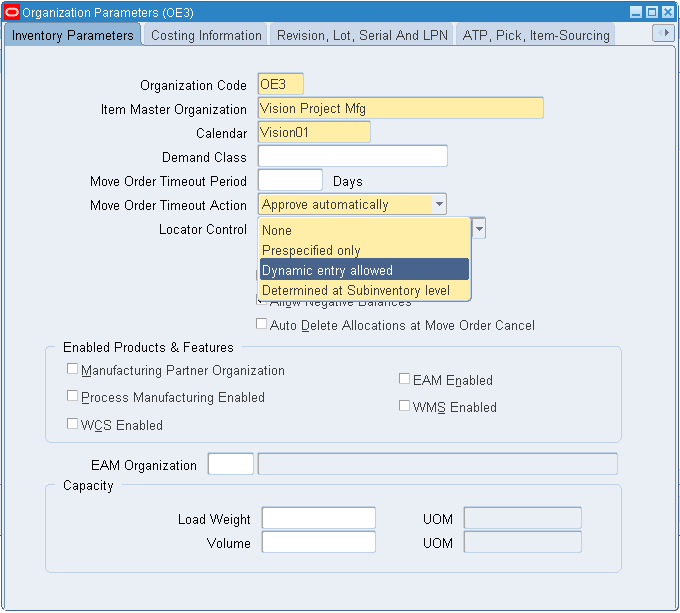
You use locator control to identify project inventory.
-
Save your work.
Project Manufacturing Parameters
Define the OEM and MP organizations as Project Manufacturing Organizations by adding Organization Classification as Project Manufacturing for both.
-
From the Inventory responsibility, navigate to the Organization window.
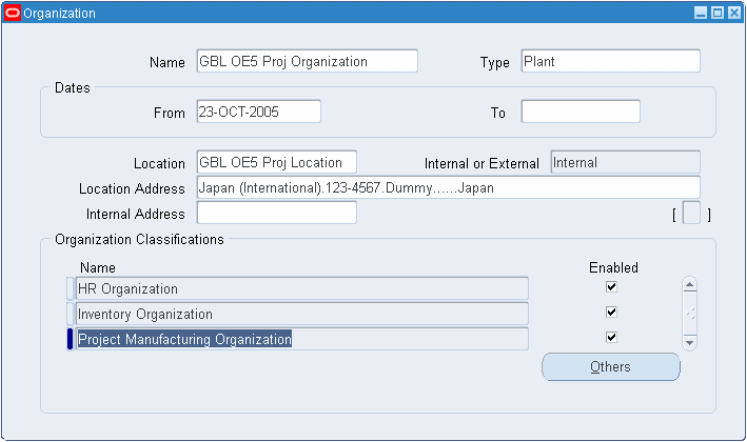
-
Navigate to the Project Manufacturing Parameters window, and click the General tab.
-
Select the Enable Project References indicator.
-
Set Project Control Level to Project.
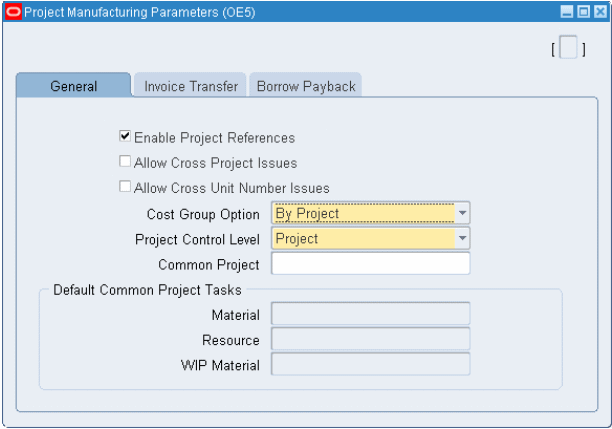
-
Save your work.
To define WIP parameters
Seiban-Based Manufacturing uses locator-controlled subinventories for inventory transactions. To support the simulation of discrete jobs in the MP organization, supply subinventory should be a locator-controlled subinventory. Interlock Manager creates WIP jobs with this subinventory as component subinventory for back flushing. The Auto Receive concurrent program also receives components into this subinventory for simulation.
-
Navigate to the Work in Process Parameters window.
-
Select the Material tab and associate Locator Controlled Subinventory as Supply Subinventory. In addition, associate Supply Locator leaving Project/Task as blank. (For details about Locators in PJM, refer to the Oracle Project Manufacturing User's Guide.)
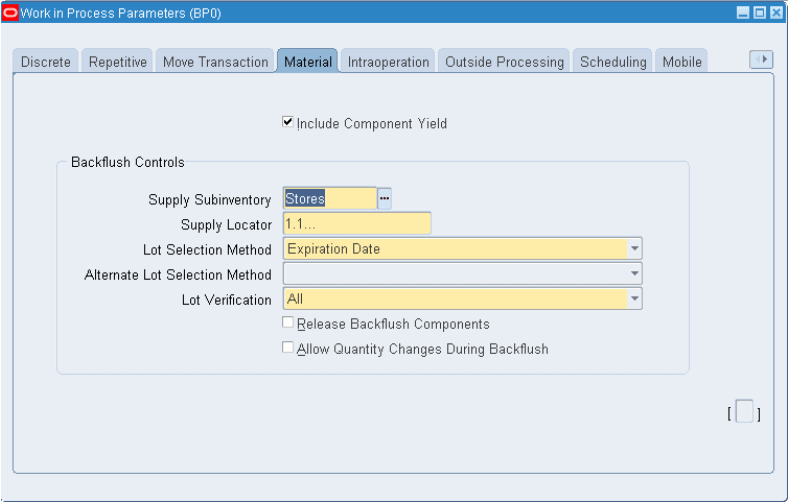
-
Save your work.
Defining Cost Groups for MP Organizations
You must define Cost groups and associate a WIP accounting class (defined at the time of creating the WIP parameters for MP organizations). This action is required for simulating WIP jobs by project numbers, and it is part of the Project Manufacturing (PJM) setup.
See: Oracle Project Manufacturing User's Guide
The MP organization is a zero-cost organization, and transfer to general ledger is set to No. Cost group setup is required to facilitate the simulation of assembly manufacturing in the MP organization using discrete jobs and project numbers. This setup does not have financial implications.
To define cost groups for MP organizations
-
From the Cost Management responsibility, navigate to the Cost Groups window.
-
Define the cost group with Type set to Inventory. You can use any existing cost group.
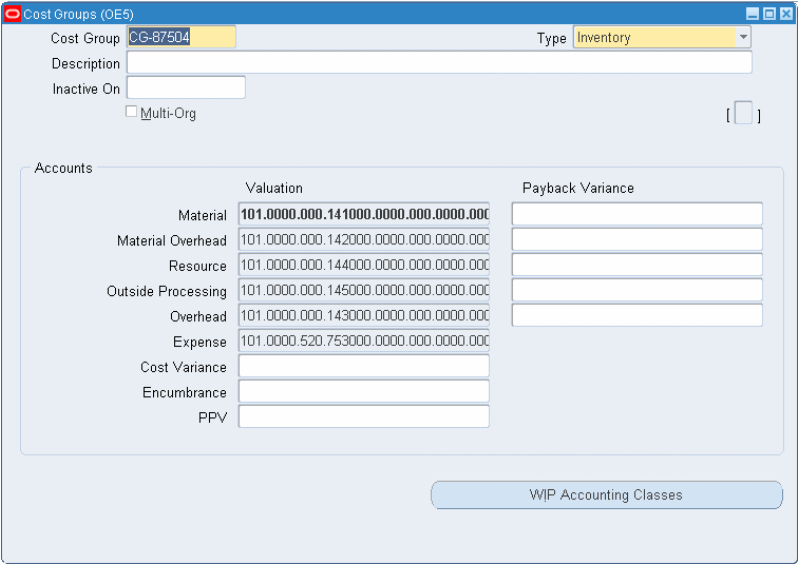
-
Click WIP Accounting Classes to define WIP Accounting Classes for this cost group (use the same WIP accounting class defined at the time of defining WIP Parameters of MP Organization). The WIP Account Classes for Cost Group window appears.
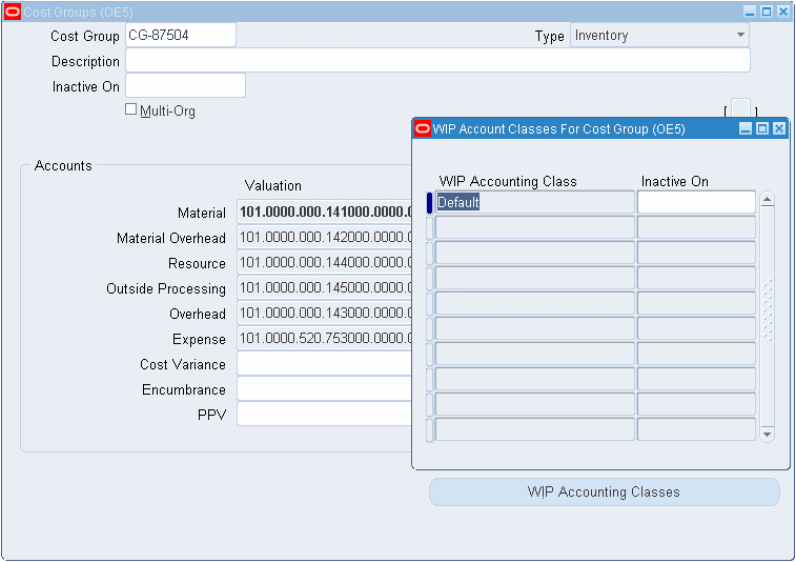
-
Save your work.
Defining Seiban Numbers
Before you plan and execute subcontracting in Seiban-Based Manufacturing environments, you define project numbers.
To define Seiban numbers
-
From the Project Manufacturing responsibility, navigate to the Seiban Wizard.
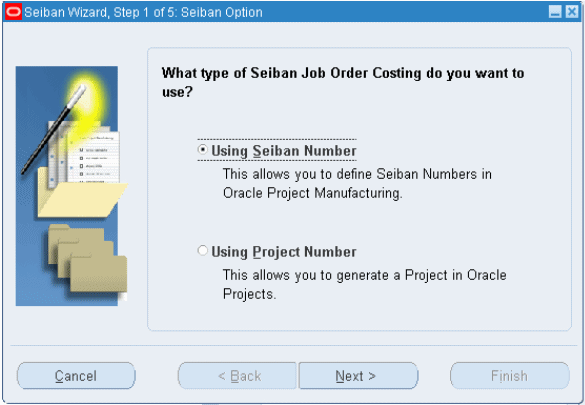
-
Select the Using Seiban Number indicator and click Next. The Seiban window appears.
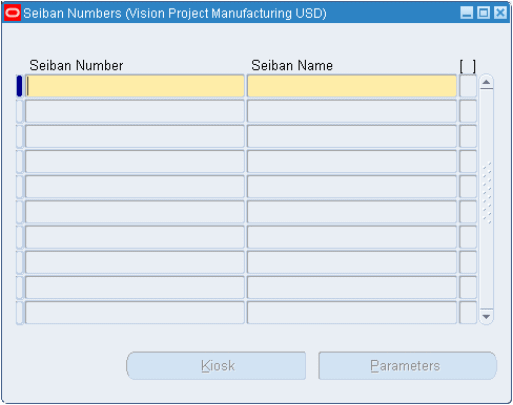
-
Enter Seiban (project) Numbers.
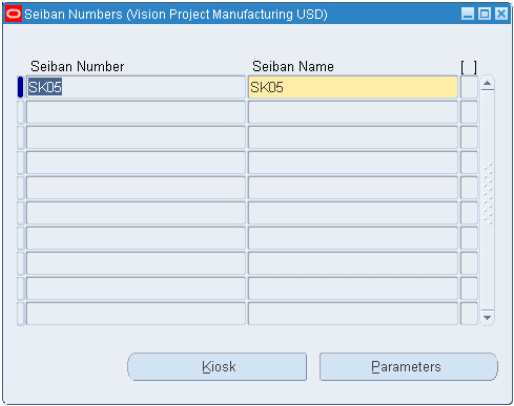
-
Save your work.
-
Click Parameters to define the parameters for the Seiban Number (project). The Project Parameters window appears.
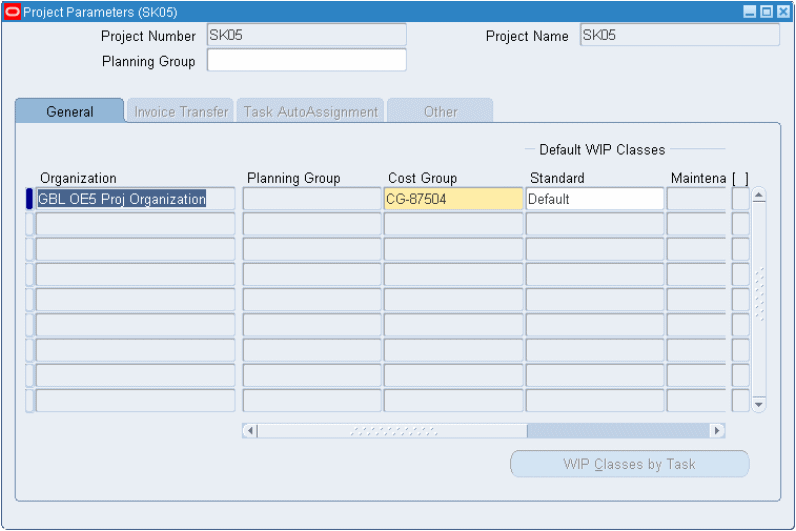
-
Select the General tab and enter Inventory Organizations that use the project numbers. In this scenario, the OEM and MP organizations should be included.
-
Associate a cost group, which was defined in the previous procedure.
-
Associate a WIP Accounting Class. This value should be same as the WIP accounting class associated with the WIP parameters of the MP organization.
-
Save your work.
Organization Items
In Seiban-Based Manufacturing, the planning and execution using Seiban numbers can be controlled by setting the Pegging attribute in the Item Master.
To define items as hard pegged
-
From the Inventory responsibility, navigate to the Organization Item window.
-
Select the MPS/MRP Planning tab. Information that you add in the MPS/MRP Planning tab is used for planning the demand and supply by project numbers. In the MPS/MRP Planning tab, set the attribute Pegging to:
-
Hard Pegging or End Assembly/Hard Pegging to plan and execute the demand and supply by project numbers.
-
Any other value (or Null) to plan and execute the demand and supply without project numbers.
Note: If a hard pegged component is also lot controlled in the External MP organization, use the Work in Process tab to set the Supply Subinventory and Locator. WIP does not use the Subinventory and Locator information from WIP Parameters for hard pegged components with Push supply type while creating component requirements. The subinventory and locator information is picked up from item definition in this case. This information is important to create allocations, receive the components into the correct subinventory and locator, and backflush from the same.
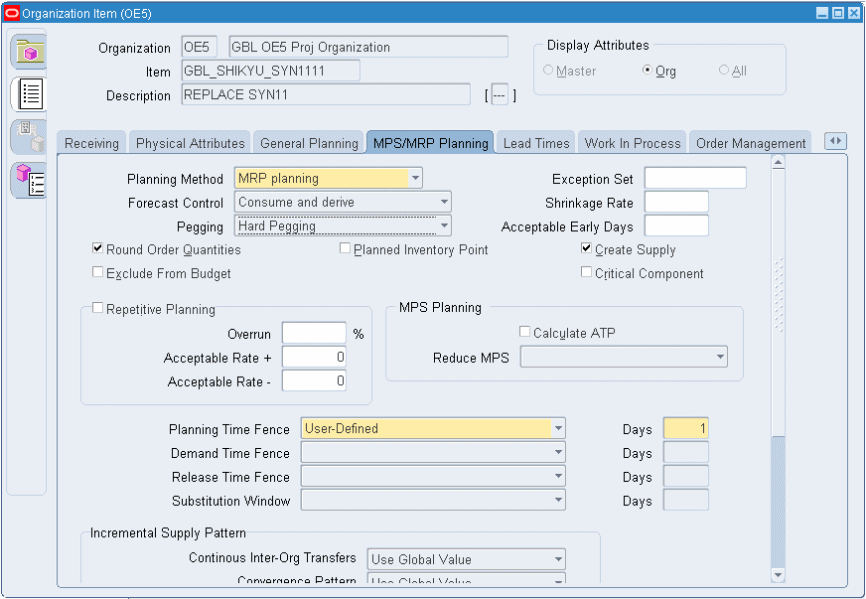
-
-
Save your work.
Seiban-Based Subcontracting Planning
The steps and processes of planning are similar to those of discrete manufacturing.
For Seiban-Based Manufacturing, the differences are:
-
Forecast must be defined by project.
-
ASCP plans the components and assemblies by project. Demand and supply are considered and calculated by project.
-
Planned orders are created by project.
-
Planned orders are outsourced as assemblies and prepositioned components. They are transferred to purchasing as purchase requisitions. The purchase orders are created with project as shipment lines.
-
For outsourced assemblies, the purchase order is called as a subcontracting order, and the project number is stamped in the purchase order line shipment distributions.
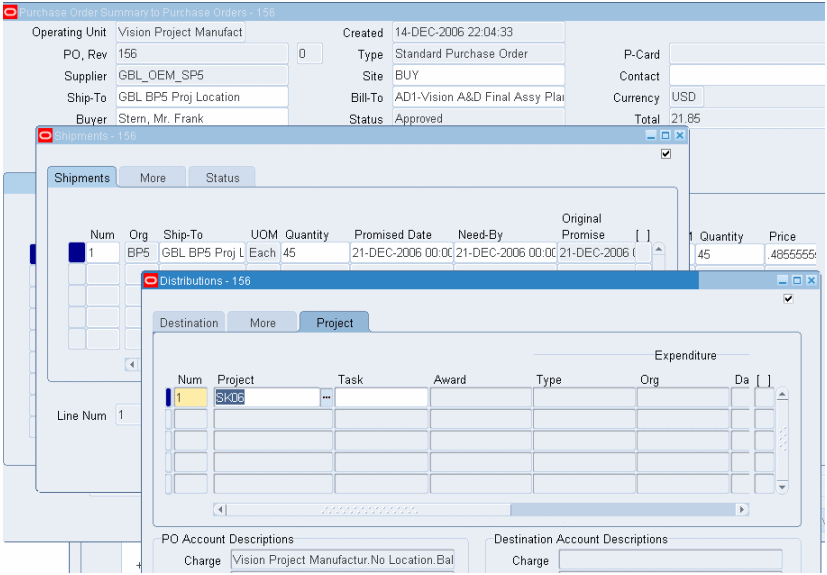
Note: Subcontracting Orders and Replenishment Purchase Orders of the prepositioned components should always have one Shipment and Distribution for every purchase order line. Multiple shipments and distributions are not supported. When you create subcontracting orders and replenishment purchase orders manually, you can create multiple purchase order lines. However, only one shipment and distribution is allowed for each purchase order line. Interlock Manager discards purchase order lines if it has more than one shipment or distribution for each PO line, and it will not process them.
For more information on concurrent programs, see Overview of Subcontracting Concurrent Programs.
Seiban-Based Subcontracting Execution
The process for executing Subcontracting in the Seiban-Based Manufacturing environment is the same as for discrete manufacturing.
Interlock Manager
The Interlock Manager concurrent request:
-
Picks up the replenishment purchase orders for prepositioned components in MP and creates associated replenishment sales orders in OEM for shipment to MP. The project and task reference are carried forward from replenishment purchase orders to replenishment sales orders.
-
Interlock Manager then picks up the subcontracting orders that were not processed in the previous run, and creates discrete jobs for the subcontracting order quantity. The project and task information is carried forward from the subcontracting orders to the work orders
For soft pegged components, the component requirement for the work order is created with subinventory and locator information defined at item level or at WIP parameters level. The subinventory and locator information is not referenced with project and task.
For hard pegged components, the component requirement for the work order is created with subinventory and locator information defined at item level or at WIP parameters level. The subinventory and locator information is referenced with project and task associated with the work order.
Note: If the component is of the Push supply type (lot controlled in External MP), WIP does not use the subinventory and locator defined at WIP parameters level while creating component requirements. Which is why for hard pegged lot controlled components that are intended to be used with project and task information, the Supply Subinventory and Locator information must be defined at item level. See Organization Items
-
Interlock Manager creates replenishment purchase orders for synchronized components. If the synchronized component is hard pegged, the project and task information is carried forward from the subcontracting order to the replenishment purchase order. If the synchronized component is soft pegged, the replenishment purchase orders are created without any project and task information.
-
Interlock Manager creates allocations for the subcontracting orders based on component requirements in the corresponding work orders. If the component requirement for a component has a locator referenced with project and task, a replenishment sales order line with the same project and task reference is allocated to the subcontracting order. On the other hand, if the component requirement for a component has a locator without any references to a project and task, a replenishment sales order line without any project and task reference is allocated to the subcontracting order.Components are shipped by OEM through replenishment sales orders.
Auto Receive Components
The Auto Receive Components concurrent request picks up these shipments in OEM and creates receipts in MP using the associated replenishment purchase orders. Sales orders that have the shipped date and in transit lead time (defined in the Shipping Networks default shipping method) as less than or equal to the current date, are automatically received to simulate the receipts in MP organization.
-
The MP manufactures the assemblies and ships the manufactured assembly to OEM. The OEM then receives these receipts like other purchase order receipts.
-
The purchase order receipts in the OEM are picked up by thee Process Receiving Transactions concurrent request.
Process Receiving Transactions
The Process Receiving Transactions concurrent request picks up the purchase order receipts in OEM and then:
-
Completes the WIP jobs for the assembly. When a WIP job is completed, components are backflushed, and the inventory is reduced in the MP organization. However, the completed assembly in the MP remains in inventory.
-
Reduces the inventory of assemblies (completed through discrete jobs) in the MP organization by performing miscellaneous issues, for maintaining the accuracy of the inventory records. This is because, the subcontracting order of the assembly is normally received in the OEM after the MP manufactures the assembly and sends it to the OEM. The Offset account defined in shipping networks is used for creating miscellaneous issues.
Note: Process Receiving Transactions program automatically completes the work orders and does the miscellaneous issues of the assemblies only for External MP organizations. For Internal MP organizations, the work orders must be completed manually and the completed assemblies must be shipped out from the MP through the Subcontracting Sales Orders.
Reconciliation Manager
Same as Discrete Manufacturing
Subcontracting Workbench
Workbench functionality is the same as for Discrete Manufacturing. All search options can be executed with a Seiban (project) number. The project number is available in additional search options, and you can personalize the search and results to view them by project number.
Subcontracting Accounting
In Seiban-Based Manufacturing, accounting is the same as discrete manufacturing. Concepts and posting of accounts remain the same.
Reports
Seiban (project) numbers are printed with all the reports, and the remaining features and functions are the same as for Discrete Manufacturing.
For more information on subcontracting concurrent programs, see Overview of Subcontracting Concurrent Programs.
For more information on subcontracting reports, see Reports Overview.